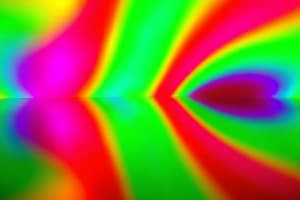Podcast
Questions and Answers
What happens to the speed of light as it passes from one medium into another during the process of refraction?
What happens to the speed of light as it passes from one medium into another during the process of refraction?
- It decreases
- It increases
- It remains constant (correct)
- It becomes zero
What determines the angle at which light travels in the second medium during the process of refraction?
What determines the angle at which light travels in the second medium during the process of refraction?
- Reflection angle
- Angle of reflection
- Angle of incidence (correct)
- Incident angle
Which law describes the relationship between the angle of incidence and the angle of refraction during refraction?
Which law describes the relationship between the angle of incidence and the angle of refraction during refraction?
- Ohm's Law
- Law of Reflection
- Newton's Third Law
- Snell's Law (correct)
What happens to light when it encounters a smooth, flat surface in a process known as reflection?
What happens to light when it encounters a smooth, flat surface in a process known as reflection?
In the law of reflection, what is the relationship between the incident angle and the reflection angle?
In the law of reflection, what is the relationship between the incident angle and the reflection angle?
What determines how much light bends or refracts when passing from one medium to another?
What determines how much light bends or refracts when passing from one medium to another?
What phenomenon occurs when light passes from a denser medium into a less dense medium?
What phenomenon occurs when light passes from a denser medium into a less dense medium?
What is the critical factor that determines whether Total Internal Reflection will occur?
What is the critical factor that determines whether Total Internal Reflection will occur?
Which principle is essential in the operation of lenses that focus light to form images?
Which principle is essential in the operation of lenses that focus light to form images?
What role does reflection play in the working of solar panels?
What role does reflection play in the working of solar panels?
How does refraction contribute to the formation of a rainbow through a prism?
How does refraction contribute to the formation of a rainbow through a prism?
What enables us to observe the Moon's topography and study its history?
What enables us to observe the Moon's topography and study its history?
Flashcards are hidden until you start studying
Study Notes
Light Reflection and Refraction: Exploring Interactions with Surfaces
Light, a form of electromagnetic radiation, behaves in interesting ways when it encounters changes in its surrounding medium. Two of these fascinating behaviors are reflection and refraction, which play crucial roles in shaping our visual world.
Reflection
When light encounters a smooth, flat surface, it bounces off that surface in a process called reflection. The angle at which the light approaches the surface, known as the incident angle, determines the angle at which it reflects away from the surface, called the reflection angle. This angle of reflection is equal to the incident angle, as described by the law of reflection:
[ \angle_i = \angle_r ]
Refraction
Refraction occurs when light passes from one medium into another, such as air and water or air and glass. In this process, the speed of light changes, causing the light to bend or refract. The angle at which the light passes from the first medium into the second medium, known as the angle of incidence, determines the angle at which the light travels in the second medium, called the angle of refraction.
The law of refraction, also known as Snell's Law, relates the angle of incidence and angle of refraction:
[ \frac{\sin \theta_i}{\sin \theta_r} = \frac{v_1}{v_2} ]
Here, (v_1) and (v_2) are the speeds of light in the first and second medium, respectively.
Total Internal Reflection
When light passes from a denser medium into a less dense medium, it can be completely reflected back into the denser medium through a phenomenon known as total internal reflection (TIR). This occurs when the angle of incidence exceeds the critical angle, which depends on the refractive indices of the two media. In this case, no light can pass into the second medium.
Applications
Refraction and reflection have numerous applications in science, technology, and everyday life. Refraction is a fundamental principle in the operation of lenses, which focus light to form images. It also plays a role in the behavior of prisms and dispersion of white light, leading to the formation of the rainbow.
Reflection is responsible for the colors we see in mirrored surfaces, as well as enabling the working of solar panels to generate electricity. In addition, the reflection of light from the Moon's surface allows us to observe the Moon's topography and study its history.
Summary
Refraction and reflection are two fundamental processes by which light interacts with surfaces. Understanding these interactions helps us to better appreciate the visual world around us and develop technologies that harness the power of light. In the next steps of your exploration, you may delve deeper into the mathematics behind these processes, their practical applications, or the history of their discovery.
Studying That Suits You
Use AI to generate personalized quizzes and flashcards to suit your learning preferences.




